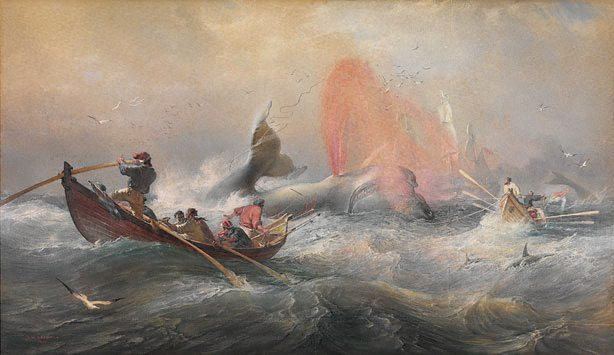 | ||
Whaling in Australia commenced in 1791 when two of the ships which had brought convicts and free settlers to the penal colony of New South Wales (Australia) as part of the Third Fleet engaged in whaling and seal hunting activities before returning to England. The main varieties of whales hunted were humpback, blue, right and sperm whales.
Contents
In 1979 Australia terminated whaling and committed to whale protection.
History
There is no record of Australian Aboriginal or Torres Strait Islander people traditionally hunting whales, although it is said that Aboriginal people did hunt with killer whales, in stories recounted at the Eden Killer Whale Museum. Aboriginal people were employed as boat crew by some whaling masters.
In 1791, Captain Thomas Melvill commanded the Britannia, one of 11 ships that departed from Plymouth in the United Kingdom 27 March 1791 as part of the Third Fleet, bound for the Sydney penal settlement. Leaving Port Jackson in November 1791, Captain Eber Bunker of the William and Ann and Captain Thomas Melvill of Britannia led the first whaling expedition in Australian waters. Britannia, became the first ship to take sperm whales on the Australian coast. Melvill was presented with a Silver Cup with the inscription:
By this time Melvill had become a valuable man, the one whaling captain knowing most of the new whaling opportunities in the Pacific, both by Peru and near Sydney. He was an experienced commander - one account describes him as experienced in that he had rounded Cape Horn a number of times. He thus helped established a whale fishery off the coast of Peru. Enderby's ships Speedy, Britannia and Ocean constantly sailed from Port Jackson whaling.
Bunker and Raven led an expedition to Dusky Sound in New Zealand before returning to England with seal skins, in addition to whale oil.
Whale oil and baleen (whalebone) were profitable commodities and whaling was one of Australia's first major export industries with coastal whaling stations being established around Australia. Sealing and whaling contributed more to the colonial economy than land produce until the 1830s.
From colonisation the whaling industry enjoyed 70 years of commercial success, until petroleum superseded whale oil. Also, the 1850s gold rush saw workers abandon whaling for the gold fields.
In the early 20th century agriculture and mining surpassed a return to whaling. However, Norwegian whalers took an interest in the Australian waters and the Western Australian government encouraged whaling to develop new locations along its coast.
From 1952 until 1962 a whaling station operated at Tangalooma, Queensland, on Moreton Island, which harvested and processed 6277 Humpback Whales during that period. It was forced to close after it had drastically reduced the number of whales in the eastern Australian Humpback population.
In 1978 the Federal Government appointed Sir Sydney Frost, a former chief justice of Papua New Guinea, to conduct an inquiry into whales and whaling. This followed a direct pro-whale action campaign in Albany, Western Australia and a national community campaign by groups including Project Jonah, Friends of the Earth and the Whale and Dolphin Coalition.
Greenpeace co-founder Canadian Bob Hunter came to Albany in August 1977 to take charge of a direct action campaign against the three whale chaser ships operating from Albany. Zodiacs were taken 30 miles out to sea to place people between harpoons and the whales. This was the first Greenpeace campaign in Australia. Key members of the Whale and Dolphin Coalition, including Jonny Lewis and Richard Jones, then formed Greenpeace Australia.
On 31 July 1978, the first day of the Frost inquiry public hearings, the Cheynes Beach Whaling Company announced its intention to close operations at the end of that whaling season. Cheynes Beach had operated from Frenchman Bay near Albany, Western Australia, since 1952. The last whale, a sperm whale, was harpooned on 20 November 1978.
Sir Sydney's report, Whales and Whaling: Report of the Independent Inquiry, recommended banning whaling in Australia, and in April 1979 the Fraser government endorsed it. Australia is now a global anti-whaling advocate and has taken a strong stance against Japan's whaling program in the Antarctic Ocean. The State Library of New South Wales holds an extensive collection of material related to whaling in its collection including art works, photographs, whalers diaries,whale bone and scrimshaw.
Anecdotal evidence suggests that whale populations, especially humpbacks, have been steadily increasing since the end of whaling in Australian waters. The current state of the sperm whale population in the Southern Ocean off Western Australia is unknown. Whale watching is an increasingly popular activity.
